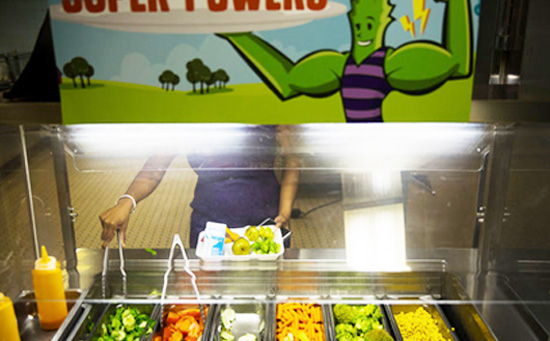About The Buzz: Vegetable Characters in Schools Increase Student’s Veggie Intake?

WHAT THEY’RE SAYING
Results from a federal government survey show that 91% of children between the ages of 2 to 19 do not have healthy diets and derive the majority of their calories from simple carbohydrates. This finding is significant, as diet greatly influences cardiovascular health. New research shows that in-school marketing strategies can help influence kids’ diets for the better.
WHY THIS MATTERS
The long and short of it is that children in the US do not have great diets. The majority of calories in US children’s diets come from simple carbohydrates, like sugar sweetened beverages, desserts and other highly processed foods. These foods are high-calorie, low-nutrition foods and consuming too many simple carbohydrates and too few fruits, vegetables, whole-grains, fish and other nutritionally dense foods leads to weight gain and poor health outcomes. A healthy diet is strongly connected to good heart health and a healthy weight.
In addition to a healthy diet, physical activity plays a major role in cardiovascular health. This study reports that among 6- to 11-year-olds, half of boys and about a third of girls got the recommended 60 minutes or more a day of exercise.1 Unfortunately, physical activity trends do not improve with age: between 16 and 19 years of age, those percentages plummeted to 10% of boys and 5% of girls. It comes as no surprise that children are heavier now than in years past, with roughly 10% of 2-5 year olds and 19-27% of children ages 12-19 being obese.1 Fortunately, nearly all children had ideal blood pressure, cholesterol and blood sugar levels. Researchers say that as the years go on, the children’s dietary patterns will eventually begin to negatively impact cardiovascular health outcomes. They recommend helping children maintain the standards of good cardiovascular – a healthy diet and daily physical activity – early on, rather than taking a wait-and-see approach.1 Schools can do so through promoting marketing strategies that encourage children to eat fruits and vegetables.
THE STUDY
A recent study, published in the research journal Pediatrics, explored the potential benefits of several marketing strategies to encourage children to eat more fruits and vegetables during lunchtime. To do so, 10 different elementary schools agreed to expose students to three different strategies: 1) a vinyl banner displaying vegetable characters that was fastened around the base of the salad bar; 2) short television segments with health education delivered by vegetable characters; or 3) a combination of the vinyl banner and television segments. Two (2) of the 10 schools did not receive any of the strategies to serve as a comparison of intervention versus no intervention. The study was conducted over a 6-week time period and included a total of 22,206 student-day observations. For strategy one, the vinyl banners were attached to the salad bar.
In strategy two (2), flat screen televisions were placed on small tables near the school’s salad bar to attract children’s attention while they were waiting in line for the salad bar. All of the vegetable characters had human attributes, such as arms, legs, and a mouth, and also had super-human strength. Characters included broccoli, carrots, spinach, peas, onions, garlic, zucchini, tomatoes, eggplant, and mushrooms.
To determine the impact of the marketing strategies on the students’ vegetable consumption, researchers needed to measure the percentage of students taking salad and vegetables during lunch. They did so by tallying the number of students visiting the salad bar each day.
RESULTS OF THE STUDY
Overall, the results of each of the strategies were incredibly successful: in schools with the vinyl banners, the number of students consuming veggies at lunch increased from 12.6% to 24.0% – nearly double! In schools with both television segments and vinyl banners, there was a more than 3-fold increase, from 10.2% to 34.6%, of students taking vegetables from the salad bar.
WHAT THIS MEANS
These findings have huge implications for schools as an effective and affordable means to increase vegetable consumption in students. Schools in this study were selected from a large urban northeastern US school district. The average household income in the school district is just under $52,000, and 82% of the students receive a free or reduced price lunch. These findings are especially significant for schools serving free and reduced school lunches to students, as many students of lower socioeconomic status may derive the majority of their daily calories from school cafeterias during before school programming, school lunch and after school programs.
Daily vegetable consumption needs vary, based on sex, age and physical activity level. The minimum vegetable recommendations for children are below:
- Children 2-3 years old: 1 cup
- Children 4-8 years old: 1 ½ cup
- Girls:
- 9-13 years old: 2 cups
- 14-18 years old: 2 ½ cups
- Boys:
- 9-13 years old: 2 ½ cups
- 14-18 years old: 3 cups
OUR ADVICE
Parents can partner with teachers and school administration to promote healthy initiatives and programming in their child’s educational environment. A first step would be to meet with school administration to understand the nutritional guidelines and practices currently underway to promote healthy eating. Once a comprehensive understanding of the current nutritional infrastructure exists, meet with other parents to discuss strategies that could further support the nutritional environment. Join the school board and participate in school-wide meetings. Draw from the results of this study and other recent research to give backing to your petition for healthy marketing in your child’s school. Engaged parents can make an impactful difference in the nutritional environment at schools.
Video Center: Selection. Storage. Preparation.
How Many Cups Do You Need?
Key Nutrients in Fruits & Vegetables
Fruit & Veggie Database



